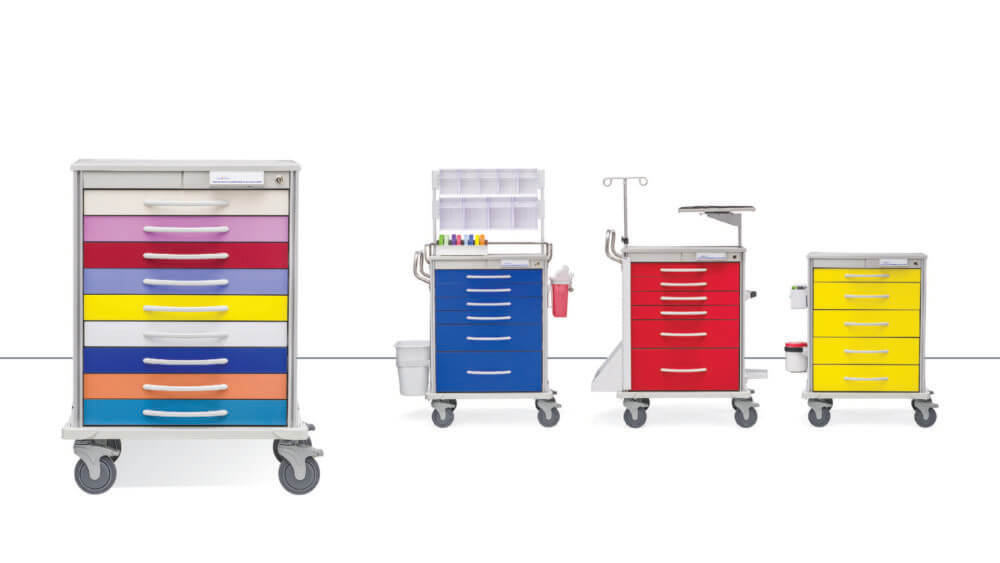
Carefully choosing the colors of procedure carts may help improve patient safety and keep supplies organized. The healthcare industry has a long history of using color coding to provide better patient care through the organization of supplies and more efficient response times.
Here are a few ways healthcare systems use color-coding:
- Color code announcements that alert staff to various emergencies
- Color-coded medication labels to improve patient safety
- Colored equipment for rapid identification during emergencies
- Color-coded towels and cleaning equipment for use in specific areas of the hospital
Is There a Universal Standard for Hospital Cart Colors?
There is no universal or U.S. standard for color coding in the healthcare system. While a code blue may be the universal signal indicating a medical emergency, there is no rule stating a hospital cannot change its medical emergency signal to a code purple.
However, color coding can create problems when the color system is not standardized. Some hospitals use colored patient wristbands to indicate certain conditions, allergies, or a do-not-resuscitate order. Unfortunately, this may create confusion when too many colors are used or employees work in multiple facilities with different color-coding systems.
According to the Pennsylvania Patient Safety Authority, a nurse applied a yellow wristband on a patient’s arm who had a limb restriction. This was the standard for the other facility that the nurse worked for, but she did not know that in this particular facility, a yellow wristband meant do not resuscitate. The patient went into cardiac arrest while wearing the yellow wristband and the attending nurse did not start CPR immediately. Fortunately, the staff identified the mistake in time to respond appropriately, saving the patient’s life.
The lack of standardization has also led to the overuse of color coding. The PA Patient Safety Authority found that different alerts were linked to the same emergency color codes, creating confusion among hospital workers. Many hospitals have implemented plain language emergency alerts to supplement a limited number of color codes.
Despite the lack of standardization, there are ways hospitals can use color coding to improve response time and patient safety. Colored procedure carts may help improve patient care and staff efficiency.
Colored Specialty Carts Stand Out
Hospitals may choose to use colored procedure and specialty carts to make them easier to identify and ensure they are restocked appropriately.
What do medical cart colors mean?
- Crash carts, or code carts, are typically red, making them easily identifiable in an emergency. Some hospitals use blue code carts, possibly to coordinate the color with the emergency signal “code blue.”
- Yellow is a popular color for isolation carts. The use of this color may originate with the stoplight color scheme, where yellow means caution.
- Blue is a popular color for anesthesia carts, possibly because blue is the color of cyanosis or lack of oxygen.
While cart colors can be adapted to the needs of the facility, there is one cart color scheme that the healthcare industry has embraced – the pediatric code cart with color-coded drawers.
Pediatric Code Carts Benefit From Color-Coded Drawers
According to the American College of Emergency Physicians, more than half of the emergency rooms in the U.S. encounter no more than 14 pediatric patients daily. Providers calculate medication dosages based on kilogram weights during emergencies when a child’s weight may be unavailable. In the same scenario, the provider needs to determine the appropriate endotracheal tube size. Using the wrong size tube can cause damage to the trachea or poor ventilation.
Back in 1986, a Hickory NC ER physician, James Broselow, felt he needed to find a better way to treat seriously ill children. He partnered with a Florida doctor, Robert Luten, to develop a tape that, using length-to-weight ratios for children under the age of 12, would help healthcare professionals quickly determine appropriate drug dosages and medical device sizes for children of any size.
The Broselow-Luten tape (now known as the Broselow tape) has different color zones that correspond to the length of the child, measured from the top of the head to the heel while lying down. Each color zone provides a size-appropriate list of emergency drug dosages, fluid volumes, and commonly used emergency equipment, such as nasogastric and endotracheal tubes.
Pediatric code carts started using the Broselow color scheme. The drawers were colored and stocked to match the zones on the Broselow tape, giving quick access to the appropriate size supplies and medication dosages.
The Broselow tape color scheme is still used on pediatric code cart drawers. Similar systems have been developed over the years and may use weight or age to determine the color zone, but the colors of pediatric resuscitation carts still follow the Broselow tape color zones.
The American College of Emergency Physicians (ACEP) recognizes the unique challenges of pediatric emergency medicine. The ACEP published a policy statement recommending that facilities organize and clearly label pediatric emergency supplies and medications for ease of use and patient safety.
Facilities can help keep communications clear by using consistent color-coding throughout the hospital system and checking to see if their state has guidelines for using colors in healthcare facilities. Pediatric emergency care providers may benefit from a pediatric crash cart stocked and labeled according to the Broselow color scheme or similar color-coding tool.

Cindy Blye
Content WriterCindy Blye, BSN, RN, CCM is a Registered Nurse and Certified Case Manager. She is an Alumni of West Virginia University School of Nursing (BSN), and a member of the Association of Health Care Journalists and The Authors Guild.
